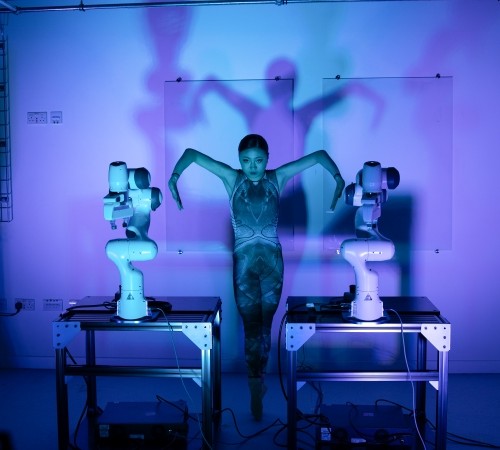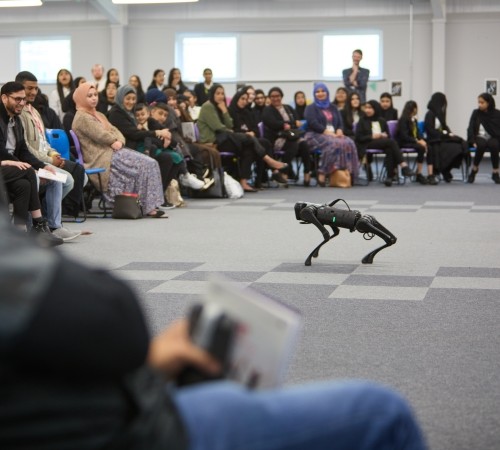The Mechanics of Life

Mayuko Iwanaga in Mechanics of Movement. Photo Sophie Beth Jones
The Mechanics of Life was a unique project funded by the Ingenious public engagement grants scheme to inspire an understanding of medical engineering and its impact on health and well-being in society.
Working with the human body as a remarkable "machine", the project involved co-production workshops with engineers, teachers, students, and artists to develop cross-curricular learning activities that connected the areas of design technology, biology, physics, mathematics and performing arts.
Dr Briony Thomas, project lead and Associate Professor of Design Science at the University of Leeds, reflected on the project’s concept: "The initial concept was to do something a little bit different and creative that would engage young people to think about engineering in a completely different way." She added, "The dancers at Northern Ballet perform amazing extremes of movement, so I challenged them to inspire engineers to think about their research differently and capture the imagination of young people."
From the classroom to the dance studio
The project took students on a journey across different learning environments. Year 8 students at Batley Girls’ High School explored engineering concepts within their classroom and participated in engineering days at the University of Leeds where they learned about the physics of movement through activities like trampolining and robotics challenges.
"We deliberately chose Year 8 as this is before they pick options for GCSE." Briony continued, "It was important to get the students to think about the breadth of engineering roles and the range of subjects and skills within these."
The collaborative process continued with an ‘experience day’ for students at the Northern Ballet studios where they compared human motion to robotic movement in a robot vs. dancer challenge, explored the physics behind pirouettes and jumps, toured the wardrobe department and considered the engineering behind theatre experiences.
One of the most impactful moments came when a former student from Batley Girls’ High School, now a PhD student in medical engineering, joined the project.
"For the students to see a young woman from their own community, now studying for a PhD in engineering, was amazing," Briony added. "It showed them that engineering could be for them too."

The Batley Girls’ High School event
Breaking down barriers for engineers
While the students were discovering engineering through dance, the engineers themselves were stepping out of their comfort zones. Briony explained: "Once they got their head around the initial ‘Briony, that sounds completely crazy’ reaction, they were really engaged."
To help ease them into creative engagement, the project included training sessions for PhD students, technicians, academics, and any engineer who wanted to be involved. These workshops provided skills in public engagement and creative communication with valuable tools for conferences, public events, and outreach.
One participant shared, "It made the creative thinking process less daunting, and I can see myself applying some of the things I’ve learned in my presentations." Working alongside dancers, teachers, and students also expanded their perspective on collaboration. As one engineer reflected, "I’d never considered working with artists before, but now I can see the value. It’s massively changed my opinion." While stepping outside their comfort zone was initially uncomfortable, many found the experience rewarding. "Doing stuff that you wouldn’t normally ever think of doing" became a common theme, with engineers embracing the project as a rare opportunity to innovate and engage in new ways.
The Mechanics of Life film premiere
The Mechanics of Life journey culminated in a special film premiere at the Everyman Cinema, where guests from the engineering, education and cultural sectors were invited. For the students, seeing their contributions come to life on the big screen was a moment of pride and excitement. "By the last event, they were so excited to see us again," Briony added, "it wasn’t just a one-off interaction; they had built real relationships with the team."
The project also made significant efforts to be culturally inclusive. Batley Girls’ High School, with a high proportion of students from Pakistani Muslim backgrounds, required careful consideration of how the dance elements were presented.
"We created multiple versions of the videos," said Briony. "There are the norms in ballet and a high-end artistic product, but we also had to ensure the content was culturally appropriate for the school community."
Watch the alternative version of the Mechanics of Life created for the school as well as the Behind the Scenes film.
Advice for future Ingenious projects
"For those looking to undertake similar co-production projects," Briony advises, "these projects always require more time than anticipated in your plans because of the need to be responsive and flexible." She also emphasised the importance of having a team with diverse skills and experiences to guide the process and make everyone feel comfortable.
Expanding the impact
Building on the success of the project, the team has continued to contribute to the university’s engagement events and fairs. Briony explained: "We've been taking concepts that we didn't have space to use – developed in the co-production workshops with teachers and artists – and we're making them into science fair activities, so that the engineers are continuing to develop and deliver on the experience."


